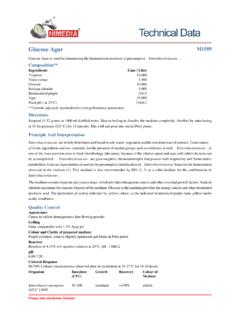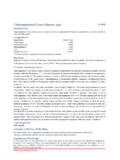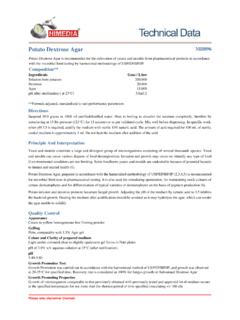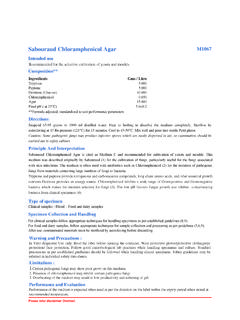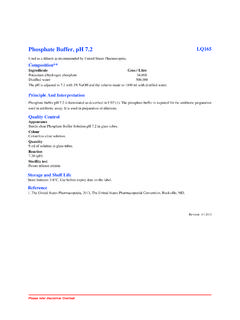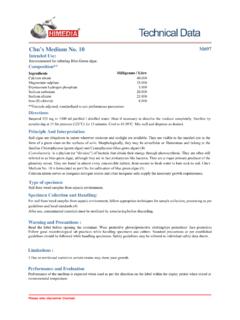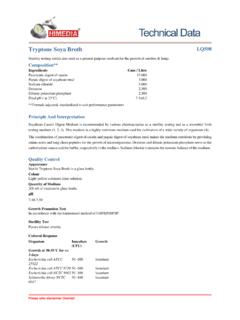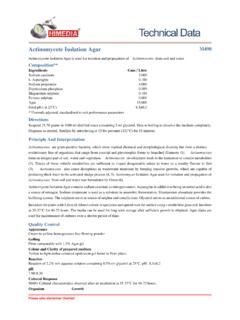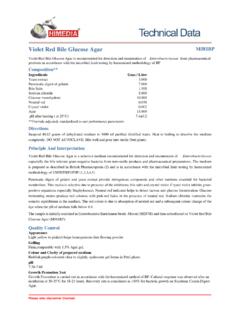Transcription of Kligler Iron Agar - HiMedia Labs
1 Please refer disclaimer iron AgarM078 Intended Use: Kligler iron agar is recommended for the differential identification of gram-negative enteric bacilli from clinical and non clinical samples on the basis of the fermentation of dextrose, lactose and H2S **IngredientsGms / Peptone B # pH ( at 25 C) **Formula adjusted, standardized to suit performance parametersDirectionsSuspend grams in 1000 ml distilled water. Heat to boiling to dissolve the medium completely. Mix well and distributeinto into tubes. Sterilize by autoclaving at 15 lbs pressure (121 C) for 15 minutes. Allow the tubes to cool in slanted positionto form slopes with about 1inch reactions are obtained on freshly prepared medium.
2 Do not use screw capped tubes or And InterpretationKligler iron agar is a combination of the lead acetate medium described by Kligler (1) and Russels Double Sugar agar (2) and is used as a differentiation medium for typhoid, dysentery and allied bacilli (3). Bailey and Lacey substituted phenol red for andrade indicator previously used as pH indicator (4). Kligler iron agar differentiates lactose fermenters from the non-fermenters. It differentiates Salmonella Typhi from other Salmonellae and also Salmonella Paratyphi A from Salmonella Scottmuelleri and Salmonella Enteritidis (5). Fermentation of dextrose results in production of acid, which turns the indicator from red to yellow.
3 Since there is little sugar dextrose, acid production is very limited and therefore a reoxidation of the indicator is produced on the surface of the medium, and the indicator remains red. However, when lactose is fermented, the large amount of acid produced, avoids reoxidation and therefore the entire medium turns iron agar , in addition to peptone, HM peptone B and yeast extract, contains lactose and glucose (dextrose), which enables the differentiation of species of enteric bacilli. Phenol red is the pH indicator, which exhibits a colour change in response to acid produced during the fermentation of sugars. The combination of ferrous sulphate and sodium thiosulphate enables the detection of hydrogen sulfide production, which is evidenced by a black color either throughout the butt, or in a ring formation near the top of the butt.
4 Lactose non-fermenters ( , Salmonella and Shigella ) initially produce a yellow slant due to acid produced by the fermentation of the small amount of glucose (dextrose). When glucose (dextrose) supply is exhausted in the aerobic environment of the slant, the reaction reverts to alkaline (red slant) due to oxidation of the acids produced. The reversion does not occur in the anaerobic environment of the butt, which therefore remains acidic (yellow butt). Lactose fermenters produce yellow slants and butts because of lactose fermentation. The high amount of acids thus produced helps to maintain an acidic pH under aerobic conditions.
5 Tubes showing original colour of the medium indicates the fermentation of neither glucose (dextrose) nor lactose. Gas production (aerogenic reaction) is detected as individual bubbles or by splitting or displacement of the agar by the formation of cracks in the butt of the medium. # - Equivalent to Beef extractHiMedia LaboratoriesTechnical DataPlease refer disclaimer cultures of suspected organisms from plating media such as MacConkey agar (M081), Bismuth Sulphite agar (M027)or Deoxycholate Citrate agar (M065), SS agar (M108) etc. are inoculated on Kligler iron agar for of specimenpure isolate from clinical, food, dairy and water samplesSpecimen Collection and HandlingFor clinical samples follow appropriate techniques for handling specimens as per established guidelines (8,9).
6 For food and dairy samples, follow appropriate techniques for sample collection and processing as per guidelines (6,7,10). For water samples, follow appropriate techniques for sample collection, processing as per guidelines and local standards.(11) After use, contaminated materials must be sterilized by autoclaving before and PrecautionsIn Vitro diagnostic use only. Read the label before opening the container. Wear protective gloves/protective clothing/eye protection/face protection. Follow good microbiological lab practices while handling specimens and culture. Standardprecautions as per established guidelines should be followed while handling clinical specimens.
7 Safety guidelines may bereferred in individual safety data Results should be noted after 18-24 hours. Else it might result in erroneous wire loop should be used for inoculation3. Pure isolates shouls be used to avoid erroneous and EvaluationPerformace of the medium is expected when used as per the direction on the label within the expiry period when stored at recommended ControlAppearanceLight yellow to pink homogeneous free flowing powderGellingFirm, comparable with agar gelColour and Clarity of prepared mediumRed coloured, clear to slightly opalescent gel forms in tubes as slantsReactionReaction of w/v aqueous solution at 25 C. pH : ResponseCultural characteristics observed after an incubation at 35-37 C for 18 - 48 (CFU)GasH2 SSlantButtCultural ResponseEscherichia coli ATCC 25922 (00013*)luxuriant50-100positivereactionn egativereaction, noblackening ofmediumacidic reaction,yellowing ofthe mediumacidic reaction,yellowing ofthe medium$ Klebsiella aerogenes ATCC 13048 (00175*)
8 Luxuriant50-100positivereactionnegativer eaction, noblackening ofmediumacidic reaction,yellowing ofthe mediumacidic reaction,yellowing ofthe mediumHiMedia LaboratoriesTechnical DataPlease refer disclaimer freundii ATCC 8090luxuriant50-100positivereactionposit ivereaction,blackening ofmediumacidic reaction,yellowing ofthe mediumacidic reaction,yellowing ofthe mediumProteus vulgaris ATCC 6380luxuriant50-100negativereactionposit ivereaction,blackening ofmediumalkalinereaction, redcolour of themediumacidic reaction,yellowing ofthe mediumKlebsiella pneumoniae ATCC 13883 (00087*)luxuriant50-100positivereactionn egativereaction,noblackening ofmediumacidic reaction,yellowing ofthe mediumacidic reaction,yellowing ofthe mediumSalmonella Paratyphi AATCC 9150luxuriant50-100positivereactionnegat ivereaction,noblackening ofmediumalkalinereaction, redcolour of themediumacidic reaction,yellowing ofthe mediumSalmonella SchottmuelleriATCC 10719luxuriant50-100positivereactionposi tivereaction,blackening ofmediumalkalinereaction, redcolour of themediumacidic reaction,yellowing ofthe mediumSalmonella Typhi ATCC6539luxuriant50-100negativereactionp ositivereaction,blackening ofmediumalkalinereaction, redcolour of themediumacidic reaction.
9 Yellowing ofthe mediumSalmonella Enteritidis ATCC13076 (00030*)luxuriant50-100positivereactionp ositivereaction,blackening ofmediumalkalinereaction, redcolour of themediumacidic reaction,yellowing ofthe mediumShigella flexneri ATCC12022 (00126*)luxuriant50-100negativereactionn egativereaction,noblackening ofmediumalkalinereaction, redcolour of themediumacidic reaction,yellowing ofthe mediumPseudomonas aeruginosa ATCC 27853 (00025*)luxuriant50-100negativereactionn egativereaction,blackening ofmediumalkalinereaction, redcolour of themediumalkalinereaction,redcolour of themediumYersinia enterocoliticaATCC 27729luxuriant50-100variablereactionnega tivereaction,noblackening ofmediumalkalinereaction,redcolour of themediumacidic reaction,yellowing ofthe mediumEnterobacter cloacae ATCC13047 (00083*)luxuriant50-100positivereactionn egativereaction,noblackening ofmediumacidic reaction,yellowing ofthe mediumacidic reaction,yellowing ofthe mediumStorage and Shelf LifeStore below 30 C in a tightly closed container and the prepared medium at 2 - 8 C.
10 Use before expiry date on the label. Onopening, product should be properly stored dry, after tightly capping the bottle in order to prevent lump formation due to thehygroscopic nature of the product. Improper storage of the product may lead to lump formation. Store in dry ventilated areaprotected from extremes of temperature and sources of ignition Seal the container tightly after use. Use before expiry date onthe label. Product performance is best if used within stated expiry must ensure safe disposal by autoclaving and/or incineration of used or unusable preparations of this product. Followestablished laboratory procedures in disposing of infectious materials and material that comes into contact with clinicalsample must be decontaminated and disposed of in accordance with current laboratory techniques (8,9).
